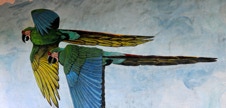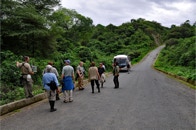
Jorupe JFP and El Empalme
Around 2:00 in the morning a very loud air-raid sounding alarm began to wail. It was deafening! One could hardly escape hearing it (although some apparently slept through it!). It went on for a good twenty minutes. Was the hotel on fire? No smoke and hotel staff were not pounding on doors. Was this an earthquake warning system? The building wasn't shaking. Was someone attempting to break into our bus? Then please TURN IT OFF! The next morning the young man who slept under the stairwell (Harry Potter-like) said it was alarm set off at a nearby establishment after someone tried to break in. Just one more bit of ambiance added to our stay in Macará.
“Curiouser and curiouser”, said Lewis Carroll’s Alice. Similar to the Hotel Roland, the Santigyn Hotel provided breakfast where “breakfast” was a word closer describing the time of day, not the meal. Two young men in the hotel’s employ ferried trays of food from the kitchen located upstairs to the lobby below. Coffee came first. Instant, to be sure but heavily laced with sucra and leche. Most of the coffee drinkers in our group preferred café negro or solo. Next came short, stemmed glasses filled with scrambled eggs. Heavily salted and overly cooked scrambled eggs. To be eaten with spoons. Small pieces of bread were brought down and as best as I can recall, there was a jam of some kind. We appreciated the effort….
However, we didn’t have much time to dwell on our food offering. We needed to be up the road and birding. Thank goodness for the extra snacks we had collected from various box lunches and stashed on our bus. Naomi and Jim had the presence of mind to bring a cache of alternative food items owing to the fact that they are vegetarians, a food life style many of us had begun to appreciate.
We were now in the Loja Province, home to some of the Tumbesian globally-threatened endemics.
Our first stop would be Jorupe JFR, a two square mile area, located a few kilometers northeast of Macará. The habitat is considered dry deciduous forest, dominated by the stately Ceiba tree. Shortly after the bus turned off the main highway, headed for the lodge, we disembarked and spent a good deal of time birding the narrow road. Today we also had to deal with drizzling rain and dense clouds, which made birding a bit more challenging.
Back on the bus again, we closed the distance to the lodge. The narrow approach made it impossible for the bus to get real close so we hoofed it the rest of the way. It was still drizzling and not knowing what lay ahead, I left my cameras on the bus. Too bad because when we got to the lodge, it was a repeat of the open-air pavilion styled building we found at Buenaventura. It had plenty of photo opportunities.
As with Buenaventura, the lodge offered brewed coffee and hot water for tea. We lounged around the building watching birds coming and going. A highlight that stood out in my mind was a Red-billed Scythebill perched on the side of a tree close to a deck railing. The bird made repeated visits to the tree with nesting material over the course of our stay and provided us with excellent close-up viewing.
One difference from Buenaventura – the lodge staff was on hand to provide us with lunch. And what a magnificent lunch it was including creamed mushroom soup with popcorn! Yum!
Birds seen in and around the lodge, including our walk up the road: Squirrel Cuckoo, Tumbes (Short-tailed) Swift, Tumbes Hummingbird, Blackish-headed Spinetail, Henna-headed Foliage-gleaner (took a lot of looking but finally got great looks), Watkin’s Antpitta (heard only), Bran-colored Flycatcher, Tumbes (Tropical) Pewee, Baird’s Flycatcher, One-colored Becard (pair building a nest), Ruflous-browed Peppershrike, Plumbeous-backed Thrush, White-edged Oriole. We also had good looks at some birds we had added earlier in the trip: Gray-and-gold Warbler, Fasciated Wren (nest building), Ecuadorian Piculet, Swallow-tailed Kite.
As much as we enjoyed the birding ambience at Jorupe, El Empalme had a few specialty birds we would need to try for and that we would have little chance of finding elsewhere. Since El Empalme was a good distance up the road, in the opposite direction from Macará, we needed to move on. The El Empalme area, in the western foothills of the Andes would have similar dry deciduous forest habitat. Just a little higher up.
At El Empalme we birded the main paved road, which gave give us spectacular views of the surrounding valleys. We picked up Tawny-crowned Pygmy-Tyrant. At one point we observed a King Vulture working well below our line of sight. Typically, looks at these birds are relegated to watching them flying high above.
The bird we had hoped to see, the White-headed Brush-Finch, eluded us. Almost. Carol and I were headed back to the bus, trailing some distance behind the main group. Carol glanced down at low dense shrubs next to the road’s edge and pointed, “there’s one – no wait! There are two of them!” Plain as day, I managed to see both birds just before they dove deeper into the foliage. The group immediately backtracked to where we were but try as we might, the birds were not seen again. Bummer.
Back to the hotel after dark, we barely had time to clean up before being bused to D’Marcos. I have to say the staff at D’Marcos went out of their way to accommodate us with meal choices and service. My stomach wasn’t feeling the best so I forewent my usual beer. My beverage of choice: Gatorade. Beer in Ecuador tended to be on the lighter side. Pilsener being a favorite of many in the group. Inexpensive and available most everywhere we stopped.
Having now settled into our Macará groove, much banter at the table took place. Mostly having to do with creative scripting of a soap opera based on a few fellows sitting at a nearby table (references to the soap opera creativity would follow us the rest of the trip). After Richard finished our daily checklist review, José filled us in on our travel plan for the next day. Then back to the hotel and our ceiling turbo-prop.





































